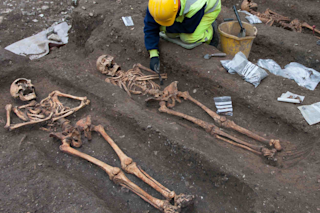When it comes to cleanliness, the Middle Ages were far from consistent. For the majority of medieval townsfolk, sanitation systems consisted solely of filth-filled cesspits — cavities cleared out of the ground for the collection of feces and other forms of garbage. Yet, for the tiniest minority of individuals, which included the residents of friaries, monasteries and nunneries, access to running water allowed for the frequent clearing out of waste.
This would suggest that the friars, monks and nuns of medieval Europe suffered from fewer soil-transmitted illnesses, but things aren’t always as they seem. In fact, according to a new, first-of-its-kind analysis in the International Journal of Paleopathology, medieval remains from the city of Cambridge reveal that intestinal worms were practically two times more prevalent among the population of Augustinian friars than the rest of the city’s inhabitants.
Parasitic Prevalence
A wide variety of merchants, artisans, agriculturalists and workers, as well as university staff and students, made up the population of medieval Cambridge. Added to the mix were the residents of religious friaries, monasteries and nunneries. Of course, the lives and living conditions of these individuals differed, and so did their susceptibility to diseases. For instance, it makes sense to assume that the friars, monks and nuns — who tended to have washing stations and toilet blocks at their residences — would’ve been better able to stave off sicknesses related to poor sanitation.
Putting this idea to the test, a team of archaeologists studied soil samples from friary and non-friary cemeteries in Cambridge. “This is the first time anyone has attempted to work out how common parasites were in people following different lifestyles in the same medieval town,” says Piers Mitchell, a study author and an archaeologist at the University of Cambridge, in a press release.
Ultimately, the team's results were rather surprising. “The friars of medieval Cambridge appear to have been riddled with parasites,” Mitchell concludes in a press release.
The Dirt on Medieval Worms
To arrive at this conclusion, the team took soil samples from around the pelvis regions of adult remains at an Augustinian friary cemetery and compared them to similar samples from the cemetery of a parish church. Specifically, the archaeologists searched for the remnants of worms and worm eggs in the soil, which would be indicative of parasitic infection.
Analyzing 19 individuals from the friary cemetery and 25 individuals from the church cemetery, the team found that 11 of the friars (around 58 percent) were infected with intestinal worms, while 8 of the townsfolk (around 32 percent) were infected with the same issue, a percentage that mirrors the data for medieval remains elsewhere in Europe. Put simply, the worms were much more common among the residents of the Augustinian friary.
Two types of worm were discovered in the remains — roundworm as well as whipworm — and because both are brought on by bad sanitation, the archaeologists theorize that the different infection rates relate to different approaches to waste management. Though the team crossed the absence of clean toilets off their list of likely causes, one possibility for the difference comes from the friars’ use of their own waste to fertilize plants in their gardens. “This may have led to repeated infection with the worms,” Mitchell says in a press release.
Despite their increased risk of infection from parasites, prior studies suggest that the individuals interred in friary cemeteries tended to live longer than the townsfolk interred in parish cemeteries, potentially thanks to a difference in diet. In the end, everything is a tradeoff. While the friars’ lives were longer, their intestines were also writhing with worms.















